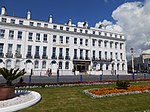Eastbourne (UK Parliament constituency)

Eastbourne is a constituency for the House of Commons of the UK Parliament. It was created as one of nine in Sussex in 1885, since when it has reduced in geographic size reflecting the growth of its main settlement, Eastbourne.The seat was re-won in 2019 by Caroline Ansell, a Conservative who ousted Liberal Democrat Stephen Lloyd; she earlier did so in 2015. Since the seat's creation it has been won by candidates from either of these two political parties (and their early forebears, the Liberal Party and the Unionist Party). The seat has had four by-elections, lastly in 1990. For 94 years of the 20th Century, the seat was represented by Conservative MPs. The seat in the 1930s saw three unopposed candidates: in 1932, March 1935 and November 1935. Eastbourne has been considered relative to others a very marginal seat, as well as a swing seat, since 1997 as its winner's majority has been at most 7.86% of the vote. A 8.9% majority Tory re-gain took place in 1992 and since 2010 the seat has changed hands (between the two parties mentioned) all four possible times.
Excerpt from the Wikipedia article Eastbourne (UK Parliament constituency) (License: CC BY-SA 3.0, Authors, Images).Eastbourne (UK Parliament constituency)
Courtlands Road,
Geographical coordinates (GPS) Address Nearby Places Show on map
Geographical coordinates (GPS)
| Latitude | Longitude |
|---|---|
| N 50.778 ° | E 0.286 ° |
Address
Eastbourne Recycling Centre
Courtlands Road
BN22 8TQ , Bridgemere
England, United Kingdom
Open on Google Maps








